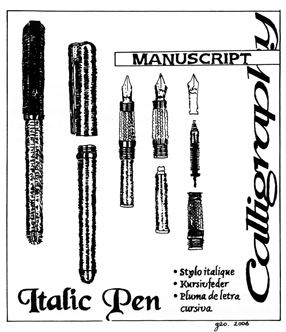When a Good Pen Goes South

If pens were lovers, the army of ex’s would be legion. And where are they now, all those ex-lovers, those “ex-pens”? Barrels hollow, empty of ink and cartridges, broken from our sitting on them? Caps shopworn and clipless, cracked from overtightening? Nibs a solid, dense mass of fused plastic, metal, and ink?
Remember the early Kohi-Nor tech pen? How about that cartridge fountain pen that put more ink onto your clothing than onto the page? The blue-ink federal Skilcraft ballpoints? How many of you formed your “writer's bump” with one of those? Or was that inflicted with a No. 2 Dixon Ticonderoga, it's hexagonal wooden side digging a deeper divot into your already callused middle finger?
While I've lost touch with most of my ex-pens, I still keep at hand the most recent, the Manuscript calligraphic pen, made by the Manuscript Pen Company, LTD, of Shropshire, England. Manuscript pens came in a variety of nibs and colors (all the while using universal ink cartridges), and they could be “field stripped,” as a noted San Francisco calligrapher, Ward Dunham, would say. With the cartridge off, the nib and ink carrier could be pulled easily from the nib holder for cleaning and, wonder of wonders, a spare cartridge would fit neatly in the bottom of the barrel, below the active cartridge and its nib.
And honey, they were cheap! About $12 could buy one barrel and cap, a Medium Italic nib, three black ink cartridges and one refillable cartridge. And for $3.28 more, you could get a packet of 12 ink cartridges in one of at least four colors. Also available were sets of nibs, including broad-tip and Italic, in three widths each, split-fountain nibs in two widths, a "music" stanza writer, and probably more. At the end of my love affair with this pen, I had 14 nibs!
But alas, this love was not one I could go to the altar with. The broader the tip, the more often I found myself field stripping it for cleaning, in coffee shops and out, my fingers stained with ink. The caps easily cracked from over-tightening, and only five barrels had I. Fourteen nibs, but only five barrels! For a cartridge fountain pen! And, when I went to buy more, I found that the Manuscript pen had disappeared.
Early in 2005 they were there, at the old Art Store (now Dick Blick), at Flax's, at Michael's (not the big chain, but the old San Francisco art store on Sutter Street), or somewhere in Pearl (the goddess knows where, and the employees were doing a good job pretending they didn't know). However, come the summer of 2005, they were gone. Without a trace. Not even a good-bye note.
So, that's why I went with the bulkier, but very available, Sheaffer Italic-nibbed pen. Who needs a cartridge fountain pen that you can't buy enough barrels and caps for, so as to keep your specialty nibs from drying out? But, I want you to know, that Manuscript No. 2B broad-tip still writes like a dream, perfectly weighted and shaped for my hand, ink flowing effortlessly from its tip. But, one nib does not a marriage make. It must have been only a fling.
Copyright © 2006 by Georgette Freeman. All rights reserved.
Looking to dignify her hand, Georgette Freeman is a student of
calligraphy, a journalist and book artist, and a retired SEC examzner.